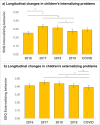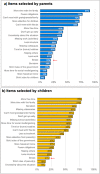Perceived stress as mediator for longitudinal effects of the COVID-19 lockdown on wellbeing of parents and children
- PMID: 33536464
- PMCID: PMC7859207
- DOI: 10.1038/s41598-021-81720-8
Perceived stress as mediator for longitudinal effects of the COVID-19 lockdown on wellbeing of parents and children
Abstract
Dealing with a COVID-19 lockdown may have negative effects on children, but at the same time might facilitate parent-child bonding. Perceived stress may influence the direction of these effects. Using a longitudinal twin design, we investigated how perceived stress influenced lockdown induced changes in wellbeing of parents and children. A total of 106 parents and 151 children (10-13-year-olds) filled in questionnaires during lockdown and data were combined with data of previous years. We report a significant increase in parental negative feelings (anxiety, depression, hostility and interpersonal sensitivity). Longitudinal child measures showed a gradual decrease in internalizing and externalizing behavior, which seemed decelerated by the COVID-19 lockdown. Changes in parental negative feelings and children's externalizing behavior were mediated by perceived stress: higher scores prior to the lockdown were related to more stress during the lockdown, which in turn was associated with an increase in parental negative feelings and children's' externalizing behavior. Perceived stress in parents and children was associated with negative coping strategies. Additionally, children's stress levels were influenced by prior and current parental overreactivity. These results suggest that children in families with negative coping strategies and (a history of) parental overreactivity might be at risk for negative consequences of the lockdown.
Conflict of interest statement
The authors declare no competing interests.
Figures






References
Publication types
MeSH terms
Grants and funding
LinkOut - more resources
Full Text Sources
Other Literature Sources
Medical

